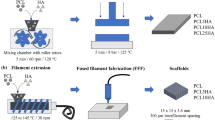Abstract
Scaffold with controlled porosity constitute a cornerstone in tissue engineering, as a physical support for cell adhesion and growth. In this work, scaffolds of polycaprolactone were synthesized by a modified particle leaching method in order to control porosity and pore interconnectivity; the aim is to observe their influence on the mechanical properties and, in the future, on cell adhesion and proliferation rates. Low molecular weight PEMA beads with an average size of 200 μm were sintered with various compression rates in order to obtain the templates (negatives of the scaffolds). Then the melt polycaprolactone was injected into the porous template under nitrogen pressure in a custom made device. After cooling and solidifying of the melt polymer, the porogen was removed by selective dissolution in ethanol. The porosity and morphology of the scaffold were studied as well as the mechanical properties. Porosities from 60% to 85% were reached; it was found that pore interconnectivity logically increases with increasing porosity, and that mechanical strength decreases with increasing porosity. Because of their interesting properties and interconnected structure, these scaffolds are expected to find useful applications as a cartilage or bone repair material.







Similar content being viewed by others
References
V. BOBIC and J. NOBLE, J. Bone Joint Surg. 82B (2000) 165
L. PETERSON, T. MINAS, M. BRITTBERG, A. NILSSON, E. SJÖGREN-JANSSON and A. LINDAHL, Clin. Orthop. 374 (2000) 212
E. B. HUNZIKER, Osteoarthr. Carti. 10 (2001) 432
C. W. Patrick Jr, A. G. Mikos and L. V. McIntire (Editors), in “Frontiers in Tissue Engineering” (Pergamon Press, Oxford 1998)
R. P. Lanza, R. Langer and J. Vacanti (Editors), in “Principles of Tissue Engineering” (Academic Press, San Diego, 2000)
A. J. Domb, J. Kost and D. M. Wiseman (Editors), in “Handbook of Biodegradable Polymers” (Harwood Academic Publishers, Amsterdam, 1997)
D. W. HUTMACHER, Biomaterials 21 (2000) 2529
P. X. MA and J. W. CHOI, Tissue Eng. 7 (2001) 23
V. J. CHEN and P. X. MA, Biomaterials 25 (2004) 2065
Z. MA, C. GAO, Y. GONG and J. SHEN, J. Biomed. Mater. Res. B: Appl. Biomater. 67B (2003) 610
R. BRÍGIDO DIEGO, M. PÉREZ OLMEDILLA, A. SERRANO AROCA, J. L. GÓMEZ RIBELLES, M. MONLEÓN PRADAS, G. GALLEGO FERRER and M. SALMERÓN SÁNCHEZ, J. Mater. Sci. Mater Med. 16 (2005) 693
D. S. JONES, D. W. J. MCLAUGHLIN, C. P. MCCOY and S. P. GORMAN, Biomaterials 26 (2005) 1761
T. HAYASHI, K. NAKAYAMA, M. MOCHIZUKI and T. MASUDA, Pure Appl. Chem. 74 (2002) 869
V. CRESCENZI, G. MANZINI, G. CALZOLARI and C. BORRI, Eur. Polym. J. 8 (1972) 449
L. J. Gibson and M. F. Ashby, in “Cellular Solids-Structure and Properties” (University Press, Cambridge 1999)
A. J. SAMARZA and A. Athanasiou, Ann. Biomed. Eng. 32(2004) 2
U. HANSEN, M. SCHÜNKE, C. DOMM, N. IOANNIDIS, J. HASSENPFLUG, T. GEHRKE and B. KURZ, J. Biomech. 34 (2001) 941
E. M. DARLING and K. A. ANASTASIOU, Annals Biomed. Eng. 31 (2003) 1114
O. DEMARTEAU, D. WENDT, A. BRACCINI, M. JAKOB, D. SCHAFER, M. HEBERER and I. MARTIN, Biomed. Biophys. Res. Commun. 310 (2003) 580
J. S. TEMENOFF and A. G. MIKOS, Biomaterials 21 (2000) 431–440
D. J. GRIFFON, M. REZA SEDIGHI, D. V. SCHAEFFER, J. A. EURELL and A. L. JOHNSON, Acta Biomaterialia 2 (2006) 313–320
R. L. MAUCK, S. L. SEYHAN, G. A. ATESHIAN and C. T. HUNG, Ann. Biomed. Eng. 30 (2002) 1046–1056
Acknowledgements
The group of the Center for Biomaterials of the UPV acknowledges the support of Spanish Ministry of Science and Education through the MAT2004-04980-C02-01 project, and the support to their research group by the Generalitat Valenciana through the project GRUPOS03/018. Julio Suay Antón acknowledges the support of Spanish Ministry of Science and Technology through the MAT 2003-05391-C03-02 project. SEM was conducted by the authors in the Microscopy Service of the Universidad Politécnica de Valencia, whose advice is greatly appreciated.
Author information
Authors and Affiliations
Corresponding author
Rights and permissions
About this article
Cite this article
Lebourg, M., Sabater Serra, R., Más Estellés, J. et al. Biodegradable polycaprolactone scaffold with controlled porosity obtained by modified particle-leaching technique. J Mater Sci: Mater Med 19, 2047–2053 (2008). https://doi.org/10.1007/s10856-007-3282-4
Received:
Accepted:
Published:
Issue Date:
DOI: https://doi.org/10.1007/s10856-007-3282-4




